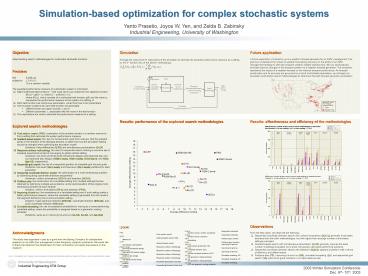2003 Winter Simulation Conference - PowerPoint PPT Presentation
1 / 1
Title:
2003 Winter Simulation Conference
Description:
Yanto Prasetio, Joyce W. Yen, and Zelda B. Zabinsky ... LEGEND. PRS Pure random search. G-FD Gradient-based search, finite differences ... – PowerPoint PPT presentation
Number of Views:28
Avg rating:3.0/5.0
Title: 2003 Winter Simulation Conference
1
Simulation-based optimization for complex
stochastic systems
Yanto Prasetio, Joyce W. Yen, and Zelda B.
Zabinsky Industrial Engineering, University of
Washington
Objective Adapt existing search methodologies
for multimodal stochastic functions
Future application A future application of
interest to us is a weather forecast generator
for air traffic management. The goal is to
understand the impact of weather forecasting
accuracy on the ability of air traffic management
strategy to alleviate airspace weather-related
disturbances. We can stochastically simulate
dynamic changes in the airspace system via a
weather forecast generator. The simulation
represents the impact of a weather forecast on
the national airspace performance. As forecast
construction and its accuracy are governed by a
set of controllable parameters, we will apply our
simulation optimization search methodologies to
determine the best forecast generator parameters.
Simulation Average the output from R
replications of the simulation to estimate the
expected performance measure at a setting on the
kth iteration (?k) of the search methodology
- Problem
- Min EOf(?,?)
- subject to L ? U
- O is a random variable
- The expected performance measure of a stochastic
system is minimized - Eight multimodal test functions 1 with noise
(error) are utilized for the objective function - f(?,?) g(?) ?, where O uniform(-x,x),
- where f(?,?), which consists of a multimodal
test function g(?) and the noise ?, represents
the performance measure of the system at a
setting, ? - Each test function has continuous parameters,
varied from two to ten parameters - One hundred variations for each test function are
generated - Different lower and upper bounds, L and U
- Different parameter, x, associated with the noise
in the test function - Five replications are used to estimate the
performance measure at a setting
Results effectiveness and efficiency of the
methodologies
Results performance of the explored search
methodologies
- Explored search methodologies
- Pure random search (PRS) exploration of the
problem domain in a random manner to find a
setting that optimizes the system performance
measure - Gradient-based search the use of a fundamental
result from calculus, that the gradient points in
the direction of the steepest descent, to
determine how the simulation setting should be
changed when optimizing the simulation model - Variations finite-differences (G-FD) and
simultaneous perturbations (G-SP) - Response surface methodology the use of a
sequential search utilizing a recursive set of
localized experiments aimed at converging to
global optimal setting - Variations two-level and three-level
full-factorial designs and balanced-star and non
balanced-star designs (RSM-2 levels, RSM-3
levels, RSM-Star-B, and RSM-Star-NB,
respectively) - Sequential grid search the use of a sequential
partition of a feasible grid into sub-grids - Variations two-level (SG-2 levels) and
three-level (SG-3 levels) partitions for each
parameter - Sequential coordinate direction search the
optimization of a multi-dimensional problem by
optimizing along coordinate directions
sequentially - Variations uniform evaluations (SCD-U) and
bisection (SCD-B) - Fictitious-play the construction of a candidate
setting from multiple settings that are obtained
by optimizing multiple sub-problems via the
decomposition of the original multi-dimensional
problem at each iteration - Variation uniform evaluations (FP-U) and
bisection (FP-B) - Improving hit-and-run the acceptance of a
candidate setting only if such setting yields a
better performance measure, where the candidate
setting is generated from the random line segment
defined by the current simulation setting - Variation hyper-spherical direction (IHR-HD),
coordinate direction (IHR-CD), and cyclic
coordinate direction (IHR-cCD) - Simulated annealing the use of acceptance
probability for moving to a worse-performing
candidate setting, where the probability is
assigned based on a geometric cooling schedule - Variations same as in improving hit-and-run
(SA-HD, SA-CD, and SA-cCD)
- Observations
- From the test cases, we observed the following
- Sequential coordinate direction search with
uniform evaluations (SCD-U) generally finds
better solutions than the other methodologies,
but with higher-than-average number of simulation
settings evaluated - Gradient-based search with simultaneous
perturbation (G-SP) generally requires the least
number of settings evaluated, but it does not
typically yield good-performing solutions - Sequential coordinate direction search with
bisection (SCD-B) appears to perform well in
terms of efficiency and effectiveness - Fictitious-play (FP), improving hit-and-run
(IHR), simulated annealing (SA), and sequential
grid search (SG) yield some good solutions in our
test cases as well
LEGEND PRS Pure random search G-FD
Gradient-based search, finite
differences G-SP Gradient-based search,
simultaneous perturbation RSM-2 levels Response
surface methodology, two-level full-factorial
design RSM-3 levels Response surface methodology,
three-level full factorial design RSM-Star-B Respo
nse surface methodology, balanced star
design RSM-Star-NB Response surface methodology,
non-balanced star design SG-2 levels Sequential
grid search, two-level partition SG-3
levels Sequential grid search, three-level
partition
SCD-U Sequential coordinate direction search,
uniform evaluations SCD-B Sequential coordinate
direction search, bisection FP-U Fictitious-play,
uniform evaluations FP-B Fictitious-play,
bisection IHR-HD Improving hit-and-run,
hyper-spherical direction (HD) IHR-CD Improving
hit-and-run, coordinate direction
(CD) IHR-cCD Improving hit-and-run, cyclical
coordinate direction (cCD) SA-HD Simulated
annealing, HD with geometric cooling
schedule SA-CD Simulated annealing, CD with
geometric cooling schedule SA-cCD Simulated
annealing, cCD with geometric cooling schedule
Acknowledgments This study was supported in part
by a grant from the Boeing Company for
collaborative research on air traffic flow
management under temporary capacity constraints.
We would like to thank the National Flow Model
team for their contribution and useful
discussions on this research.
- 1. M. Ali, C. Khompatraporn, and Z. Zabinsky. A
Numerical Evaluation of Several Global
Optimization Algorithms on Selected Test
Problems. Journal of Global Optimization, to
appear.































